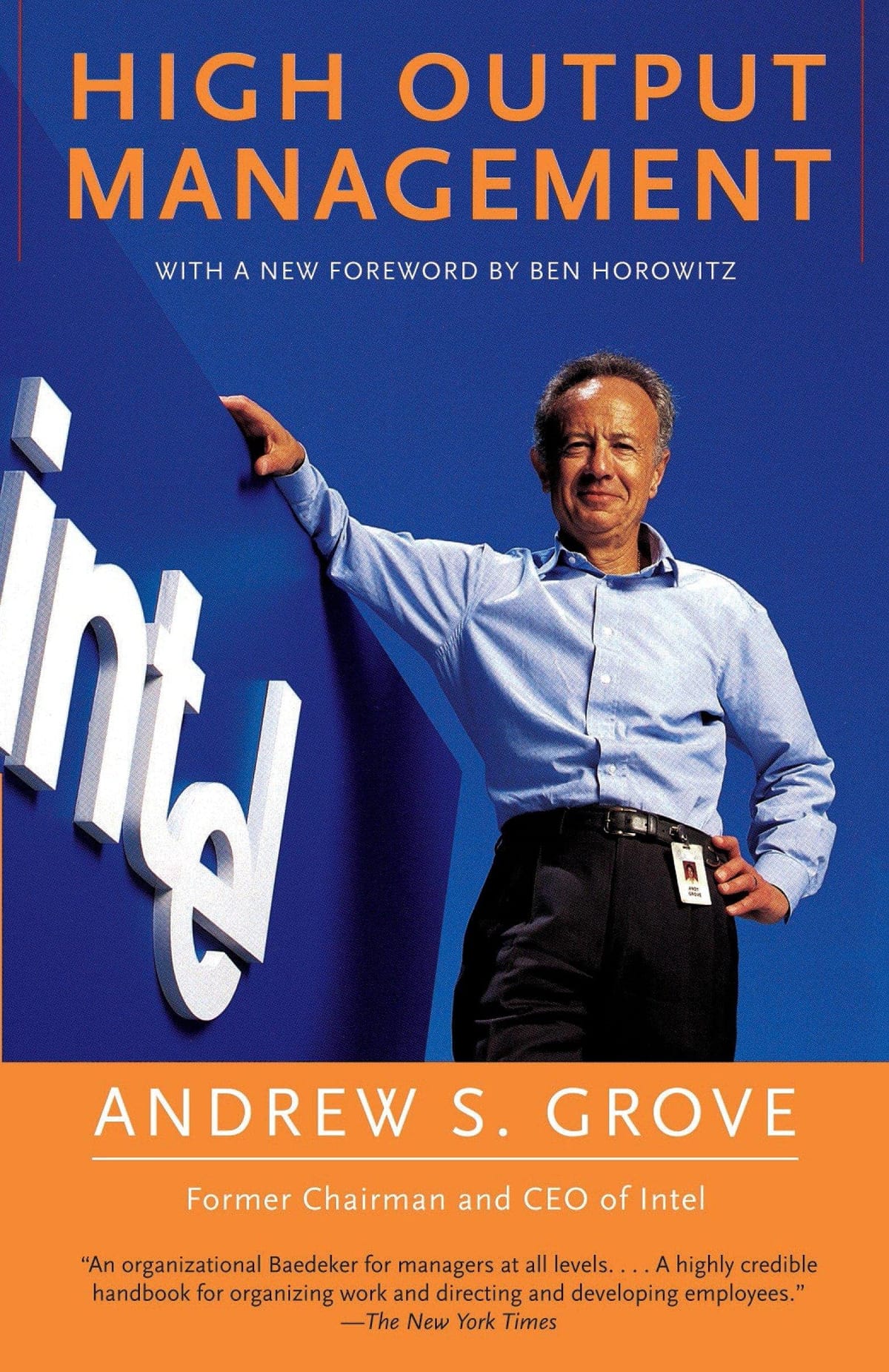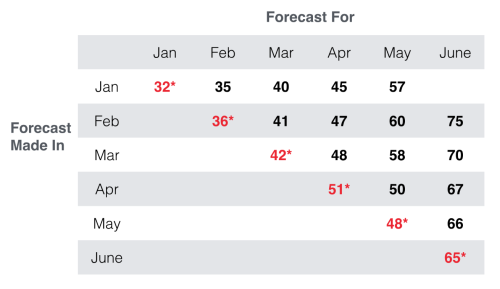Notes on “High Output Management” by Andrew Grove

Originally written on 2016 May
High Output Management is a management book by Andrew Grove, who was the long-time CEO of Intel and oversaw Intel’s pivot into becoming the largest semiconductor manufacturer. So he probably knows what he’s talking about.
Grove defines management as being all about maximizing the output of your team. Your productivity as a manager is defined as the total productivity of your team. It doesn’t matter what you know if your team doesn’t know it.
People not getting things done is a result of either a lack of capability or a lack of motivation. Both are your fault as the manager. You need to make sure people have what they need to get the job done and that they are sufficiently motivated.
Leverage
Grove defines High leverage tasks as tasks that affect a lot of people and/or a lot of work time with little of your own time. For example, teaching someone could take an hour of your time but make months of their work better. Planning, coordination, and disseminating information also are all high-leverage. A manager should be aiming to maximize leverage.
Negative behaviors (e.g., depression, waffling, meddling, micromanaging) can often be high leverage too, which would result in a very large negative effect even from a small amount of initial manager negativity. Watch out.
Everyone in the company, including managers, have unique skills and knowledge that can be leveraged to make widely affecting judgement calls about how things will be done. This is an important form of management that an individual contributor can make.
The art of management is cultivating a wide variety of very high leverage abilities and then exercising the few that are the highest leverage.
The Five Roles of the Manager
- Information gathering - collecting important information.
- Information giving - disseminating relevant information to others, whether it be in informal communication, meetings, or formal lectures. Your job is to make sure everyone knows what they need to know and prevent them from all wasting time figuring it out on their own.
- Nudging - Guiding people to more correct decisions.
- Decision making - Making decisions.
- Role modeling - Demonstrating values that people should have.
Information Gathering
Information is the key currency for the manager.
When gathering information, quick verbal exchanges are often the most efficient but may be misleading. You should cultivate a wide variety of sources, including objective indicators, formal meetings, informal discussions (e.g., talking to someone in the lunch line), and even just simple observation.
Indicators
As a manager, you need to know, as objectively as possible, what state you are in. To do so, you build indicators. Indicators can measure outputs or show trends. Grove likes to use the stagger chart where you continually compare forecasts to actual results:

You’ll also need to keep track of leading measures, which are first signs of where things are going, and lagging measures, which are signs of where things were. Leading measures are useful as early warning signs, but lagging measures are often more objective, more valid, and easier to measure.
For example:
Measuring research productivity as a professor
Leading measure: Number of hours worked on research
Lagging measure: Number of paper citations
Measuring productivity as a programming team
Leading measure: Number of hours worked, milestone completion rate
Lagging measure: Quantity and quality of projects shipped
Measuring customer satisfaction
Leading measure: Rate of customer complaints
Lagging measure: Rate of customers referring other customers
Generally, people over-emphasize positive leading indicators when the lagging indicators are bad. Also people under-emphasize the danger of negative leading indicators, especially when the lagging indicators are good. Things can go from good to bad pretty quickly, and recovery in the leading indicators can often be false hope.
If you’re only acting on negative leading indicators you’re too late.
Planning
Planning is one of the highest leverage tasks a manager can do, as it sets the stage for everything their reports to. Planning is about looking at the external demands into the future, forecasting the current supply to meet those demands, and then reconciling if supply is misaligned or insufficient.
Information Giving
A leader needs to make sure everyone knows what they need to know. All layers of management, including the ground-level contributors, must be on the same page about what is going on.
Power
In a company, knowledge is literally power. While there is often power based on position, there is also power based on knowledge.
Most importantly, there is a tension between positional power and knowledge power, as managers get more distant from the technology as they grow in their position. This means managers most frequently don’t have the knowledge power they need.
Meetings
Meetings are very expensive in terms of staff time (10 people in a meeting who each earn $60/hr mean the meeting costs $600/hr!) and should be looked at with skepticism and scrutiny. Meetings should be cancelled or replaced with a lower cost alternative (e.g., email) when possible.
However, meetings have an unfair reputation as being the place where productivity goes to die. In fact, meetings are often the best place for a manager to exercise his or her leverage and do the Five Roles.
There are two types of meetings:
- process meetings: regularly scheduled meetings that aim to exchange information
- mission meetings: usually ad-hoc meetings where a particular problem is solved and/or a decision is made.
Process meetings should be predictable for everyone and regularly scheduled.
All meetings must have concrete agendas that are sent out ahead of time and stuck to during the meeting, or else the meeting will get derailed.
Mission meetings should have less than eight people or it gets too crowded. Ideally mission meetings can be dealt with in the course of the regular process meetings. Spending more than 25% of your time in ad-hoc meetings is a sign of mismanagement.
1-1 Meetings
The most special form of process meeting is a 1-1 meeting between the manager and the report. These should be regular, based on experience of employee and pace of work, and have the agenda set by the employee. The supervisor should keep things on track but subordinates should do most of the talking.
1-1s give the manager the opportunity to learn. A good thing to focus on are performance metrics and current problems and potential problems. Manager facilitates 1-1 and asks questions and takes notes to get the employee to share their problems. The manager should ask about their dissatisfaction with work, their performance, and if they have any frustrations or doubts. However, the manager should avoid triggering really bad news right at the end of the meeting, as this can derail your schedule.
Decision Making
Decision making should aim to answer these six questions:
- What decision needs to be made?
- When does it have to be made?
- Who will decide?
- Who will need to be consulted prior?
- Who will ratify or veto the decision?
- Who needs to be informed about the decision?
There are two types of decisions:
- Reactive decisions: A certain bad thing has happened in the past and we need a way to deal with it.
- Proactive decisions: Making a decision to create something awesome or avert something bad in the future.
Decisions should be made by people with knowledge. Even if a manager has a lot of positional power, they should act as a facilitator for the people with knowledge power.
Meetings with a bunch of people at the same rank end up with people talking in circles and making no progress. A single facilitator of a higher rank can keep the conversation on track.
The ideal decision making process is free discussion -> clear decision made -> full support for the decision. Repeat this cycle if the decision ended up being wrong.
Notably, full support does not require agreement. Though mangers sometime have a hard time supporting decisions they don’t agree with, they should recognize that it is important to make tough and controversial decisions, and let things go.
It is sometimes necessary to wield positional power to make a decision if sufficient free discussion has occurred and no consensus has emerged, but it is often dangerous to wield your power before then before then.
Scheduling
The job of the manager is to work with their employees. A good rule of thump is to expect to devote a half day per week to each employee. This would suggest that managers top out at 6-8 reports.
Managers need to work based on their calendar, so they can make it clear what they can and cannot do and when they expect to get certain tasks done. Communicating capacity clearly will avoid a lot of problems down the road.
Additionally, schedules need a certain amount of slack to them, to allow for things to go over and for sudden things to come up. Therefore a schedule that is mostly full should still be presented as a full schedule.
The biggest risk to the schedule is interruptions from people who need to know things. One might be tempted to hide from others, but this leads to people being blocked for large amounts of time and for issues to pile up. Work should be done as much as possible to anticipate issues ahead of time and deal with them in regular informational meetings and building an FAQ.
Delegation
Delegation is the key activity of the manager, or else the manager would be doing 240 hours of work a week and the employees wouldn’t get anything done. However, delegation requires active management, otherwise it is abdication.
The most important form of management during delegation is making sure the delegated employee knows everything they need to know to be able to complete the activity correctly.
The second most important aspect is monitoring, or quality assurance. Monitoring should be done at the lowest value-added stage, such as at the rough draft, to avoid the employee spending too much time going down the wrong path (e.g., polishing the incorrect draft into a final draft). Monitoring also can be done at random, rather than involve a full check of all the details.
The amount of monitoring for an employee is based on how much task-relevant maturity (TRM) they have – basically how much prior experience they have with that kind of assignment. A junior employee with low TRM may require monitoring multiple times a day, whereas an employee with high TRM could be left alone for multiple weeks. Note that even a very experienced employee could have low TRM if they are doing something new.
Performance and Reviews
If performance matters, performance reviews matter. But first you must know what you want from your employees (or you certainly won’t get it).
Care should be taken to assess and review based on actual performance, not potential. Employees who are producing a lot of future gains that are not realized yet can be evaluated according to present value calculations.
Assessing the performance of a manager is a matter of assessing the total output of that manager’s organization. Usually, you assess based on whether the manager is meeting the schedule. Failures of the organization are failures of the manager. You can also often ask the manager’s employees how well the manager is doing.
You always must aim to improve your employees’ performance. Their lack of performance is usually attributable to a failing on your part.
Feedback
Three Ls of feedback: level (be frank and honest), listen, and leave yourself out of it.
When giving a rating, you must define what the subordinate needs to do to both maintain and to improve his or her rating.Reviews should be written, given to the employee in advance, and then discussed, before finalized.
Promotions
Promoting someone communicate values, so you must promote your best performers.
The Peter Principle suggests that people are promoted to incompetence, as people who do well keep getting promoted until they stop doing well. However, this does not account for how people learn and improve, leading to a cycle of meeting expectations -> exceeding expectations -> promotion -> meeting expectations.
If you followed the Peter Principle and did not promote your best employees, you would have an even bigger waste.
If someone isn’t performing well enough after a promotion, the best option is to return them back to their previous position and give them a second chance. This is better than firing them and usually the embarrassment is temporary.
Interviewing
In an interview you need to be careful about the clock and not be afraid of cutting off rambling nervous people. You should ask about accomplishments, current problems, failures, and what they learned about failures.
Training
Managers should also do training. You should design training courses. These can have incredible returns. The first time going through it won’t be good, but you’ll get better.
Handling someone quitting
If one of your people tells you they want to quit and you want them to stay, immediately drop everything and listen to them, then ask questions, then talk it over with your supervisor.



